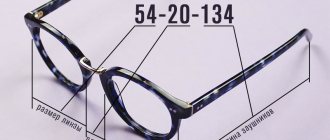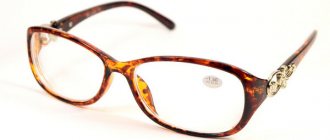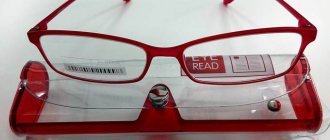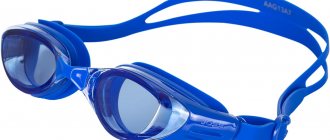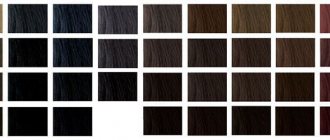What is a frame and why is it needed?
From a purely utilitarian point of view, the frame is nothing more than a device for fixing lenses. Its task is to ensure the correct position of the lenses in front of the eyes. The ideal position is one in which the middle line of the light openings (the light opening is the space limited by the rim of the frame) passes approximately through the centers of the pupils or slightly lower. It is optimal when the back surface of the lenses is at a distance of 12 mm from the top of the cornea. The only exception is the so-called half-glasses, which make it easier to transfer the gaze from long distances (over the glasses) to near ones (through the glasses). In practice, the fit of the frame often results in a slightly elevated position of the pupil relative to the center line of the light aperture.
Glasses for different face shapes
When choosing glasses, you should consider your face shape. Framing must be selected as carefully as clothing. There are configurations that emphasize advantages and disguise small flaws. Any face shape can be complemented by the right eyewear design.
After choosing your own style and image, it is easier to choose the right option. Special frames can be selected for diamond-, pear- or heart-shaped faces.
Frame elements
The frame consists of two main parts, namely the frame, which secures the lenses, and the temples, which ensure the specified position of the glasses. The light openings of the frame, limited by the rim, are connected to each other by the so-called bridge, or bridge, or bridge of the nose - the nose part of the frame. Considering that the maximum weight of the finished glasses falls exactly on the bridge of the user’s nose, it is important that the frame ensures the greatest fit of the glasses in this part, and the weight is distributed evenly. Most metal frames, for better fit on the face, are additionally equipped with movable, adjustable nose pads, usually made of silicone or rubber. Specialists in the production of plastic frames successfully solve the problem of fixing and distributing the weight of finished glasses through the design of the frame itself.
The connection between the frame and the temples is carried out using a hinge joint. Sometimes spring-loaded, or flex, hinges are used in the production of glasses. The use of high-quality hinges has a positive effect on the fixation of glasses on the head and their service life. To avoid possible allergic reactions of the skin to metal and compression of the head in the temple area, metal temples are equipped with tips made of hypoallergenic material, such as silicone.
Frames, depending on their design features, can be divided into the following types:
- Rimless, or full-rimmed, frames are frames in which the light openings are completely limited by the rim. Along with metal and plastic, there are also combined models of rim frames, for the manufacture of which both plastic and metal are used;
- Semi-rimmed frames are frames in which the upper part of the light openings is limited by the rim (much less often – the lower part). In addition to the half-rim, nylon fishing line is most often used to attach the lenses in these frames. Semi-rimless frames can be plastic, metal or combinations;
- Rimless frames are frames that do not have a frame. The lenses are held in place by screw fastenings. In traditional rimless frames, the lenses typically have holes in the nasal and temporal portions into which a screw is inserted from the front of the lens and secured from the inside. There are designs that allow the screw to be inserted from the inside, and special decorative fasteners are used to secure it from the outside. One of the advantages of rimless frames is that they are hardly noticeable on the face. However, it should be borne in mind that the use of negative and positive high-refraction spectacle lenses for assembly into rimless frames often negates this advantage;
Shapes of glasses
In addition to classic accessories, they are also made in other shapes. Nowadays, there are fashionable frames that suit a certain style.
Framing forms:
- Classic. These glasses are suitable for daily use and are appropriate for any place and event. Not all women and men like to experiment with their appearance, which is why classic accessories are in constant demand.
- Cat-shaped glasses. They are mostly chosen by young girls. This image gives lightness, coquetry and playfulness. These glasses will highlight any style option and also soften the look of a woman in a classic suit.
- Round eyeglass frames look most attractive on faces that have a square or triangular shape.
- Oval. Many people like glasses for their versatility. They suit all face types.
- The triangular shape is quite rare. It is suitable for particularly extravagant looks.
- Butterfly glasses. Such accessories have not lost popularity for several decades. They are most suitable for chubby women.
- Square shape of glasses. They are not suitable for everyone. Accessories look ideal on oval-shaped faces.
How to choose glasses frames by type? Each person is individual, so there are no accessories that suit everyone without exception. However, some experts consider the aviator shape to be universal. This is because the glasses are suitable for both men and women. They can be worn on any face shape.
Frame materials
The choice of material from which a spectacle frame is made largely determines its appearance, weight, service life, as well as some other characteristics. The main materials for the production of eyeglass frames are plastics and metals.
Plastic frames.
Types of plastics used to make frames:
- Cellulose ethers. Among plastics, cellulose acetate remains the most popular. Today, the optical market offers both frames made from milled multi-layer cellulose acetate and the ever-fashionable black glasses. In addition to cellulose acetate, cellulose propinate is also widely used - mainly for injection molded frames;
- Polyamides. Depending on the manufacturer, these types of plastics have certain names. One of the most popular plastics today is grilamid. Polyamides are often used to make sports glasses because their main characteristics include flexibility and strength;
- Optil and other materials based on epoxy resins. Optyl is a material created on the basis of epoxy resins; it is 20% lighter than acetate. This type of plastic is also used to make sports glasses. In addition, it has outstanding decorative properties, since it allows you to include “alien” elements - pieces of fabric, metal, etc.;
Metal frames.
Types of metals used to make frames:
- Steel. Among metal frames, stainless steel frames are becoming increasingly common. Frame manufacturers value such properties as corrosion resistance, hypoallergenicity, flexibility, lightness, and durability. Its wider distribution in spectacle optics is hampered by its rather high cost; in addition, steel becomes brittle when exposed to high temperatures;
- Aluminium. Currently, the number of products made from various aluminum alloys is increasing. This material is 3 times lighter than steel and 2 times lighter than titanium. Milled frames that are resistant to corrosion can be made from aluminum alloy sheets. Today, aluminum is considered one of the most promising materials for eyewear optics - it is as durable and corrosion-resistant as cupronickel, and at the same time much lighter;
Metals with memory.
There are two groups in this category: copper and titanium alloys. Due to their high elasticity, frames made from these alloys can return to their original shape after deformation. While lightweight, they are more durable and flexible than plastic frames.
- Beryllium. This metal is often used to strengthen alloys. It is light and very hard;
- Bronze. This alloy of brass and copper is sometimes used to make temples. Due to its elasticity, it has high impact resistance;
- Cobalt. This metal is widely used in Japan, it is very durable, used in alloys, and is well suited for making very thin frames;
- Cupronickel. As you know, it is an alloy of copper (base), nickel, manganese and iron. In eyewear optics, various versions of cupronickel are used, differing in the exact composition and proportion of each component of the alloy. Cupronickel silver is used in the manufacture of almost 80% of metal frames, as it is very economical and easy to work with in production. The disadvantage of cupronickel is its rather high nickel content, which makes it necessary to apply a protective film. Cupronickel is often used in combination with Monel. Used for the manufacture of components;
- Monel. It is an alloy of nickel and copper (with nickel making up more than 50%) with the addition of iron and manganese. Monel is very widely used for bridges and frame openings. Monel is highly durable and resistant to corrosion, and is flexible enough to make it easy to work with;
- Gold. Pure gold has increased corrosion resistance and high chemical resistance. The use of alloys increases the strength of gold and reduces the cost of glasses. To make glasses from solid (pure) gold, gold alloys from 10 to 24 carats are used. Solid gold is a too soft material, easily deformable, frames made from it require special care;
- Gold coatings. There are many techniques for applying gold plating - for example, the electroplating method or the gold overlay method. The coating thickness must be at least 3 microns. In addition, frames are made with gold plating - the thickness of this coating ranges from 0.25 to 0.5 microns;
- Titanium is today's star among materials used to make eyewear. It is hypoallergenic, resistant to corrosion, and its advantages include lightness, strength, and resistance to high temperatures. In addition to titanium, titanium alloys are also widely used in optics;
Selection of frames taking into account your individual characteristics
Choosing frames is not an easy task. In order to solve it, there are several things to consider:
- your face type;
- your preferred style of clothing;
Determination of face type
Determining the type of face, or, in other words, its shape, is not difficult. Secure your hair with a headband or bandage so that it does not bother you, and stand close to the mirror. Outline the contours of the face (from the roots of the hair to the chin) with lipstick or a water-soluble marker and evaluate the result.
Characteristics of types of faces
With all the diversity of faces, five main types are most often distinguished: oval, round, triangular (heart-shaped), rectangular and trapezoidal.
- Oval face. It is characterized by a smooth transition from the forehead to the cheekbones, and then to the chin, the widest point being at the level of the cheekbones. The bottom of an oval face is usually longer than the top.
Recommended:- frames of almost any shape, from classic to avant-garde;
- frames are slightly wider than the size of the face at the widest part, in order to reduce the elongated oval of the face (as a rule, elongated faces are also quite narrow);
- massive frames with a wide, low bridge of the nose, which can distract attention from a long narrow nose, and with low-slung temples, which help neutralize the effect of elongation (especially if the lower and upper rims of the frame are formed by horizontal lines);
Not recommended:
- too large frames that will be dissonant with facial features;
Recommended:
- frames with straight lines forming pronounced angles with the sides;
Not recommended:
- frames too small;
- round frames;
Recommended:
- frames with oval or round light openings, frames with rounded edges;
Not recommended:
- bulky frames that will enhance the triangle effect: the chin will look even narrower and sharper, and the forehead area will look even wider;
- cat eye frames;
- frames with high temples;
Recommended:
- rounded, oval frames that will help smooth out angularity and lighten the heavy lower part;
Not recommended:
- angular frames that emphasize the heaviness of the face;
- frames that are too small and dissonant with facial features;
- frames with low-slung temples;
Recommended:
- cat-eye frames to add width to the top of the face and draw attention away from the chin;
Not recommended:
- any frames that emphasize the heavy lower part of the face;
- frames with low temples;
Preferred clothing style
The preferred style of clothing is largely determined by a person’s lifestyle. With all the variety of styles, we will highlight the three most capacious:
- Business style
The main features of business style, or business style, are rigor, restraint, functionality, and conciseness. In addition to a business suit, an important attribute of modern business style are glasses for vision correction. A good solution for a business person may be politically correct rimless glasses that do not limit the field of vision with frames. Sometimes they are called glasses of politicians due to the latter’s special commitment to them. They are also often chosen by the hosts of political talk shows and other intellectual programs. To create rimless structures today, materials such as stainless steel, titanium and titanium-based alloys are often used.It's much easier to be seen as a democrat with rimless or aviator glasses than with strict rectangular cellulose acetate sunglasses. However, the latter will be quite appropriate when a business person needs to strengthen his authority, which is especially important when he takes his first steps in business. At the same time, however, one cannot ignore his face type.
- Extravagant style
Extravagant style is often preferred by students and people of creative professions (artists, fashion journalists, photographers, designers, bloggers). They love contrasting combinations, bold shapes and colors, unexpected combinations of textures, asymmetrical cuts and bright accessories, including, of course, glasses. Plastic glasses made in retro style, or genuine vintage glasses, can also look very extravagant. When choosing frames, special attention should be paid to color. Fans of extravagant style often gravitate towards bright colors. A good solution may be frames made of two- or three-layer cellulose acetate, which combine several colors at once. The result of overdubbing can be a completely boring mix! - Casual style (everyday)
Casual is a style in which the main emphasis is on convenience and comfort. This style is quite diverse and, among others, includes the following areas:- Sports-casual. Its name speaks eloquently for itself. Fans of this substyle are modern residents of megacities, whose lives are dynamic and fast-paced. The ideal clothes for them are classic jeans, T-shirts, polos, and the ideal shoes are sneakers, but not those designed specifically for sports, but special “urban” models. The ideal glasses for them will be fashionable sports models created specifically for fans of an active lifestyle;
- Smart casual. This substyle is less strict than the traditional business style. It is often also called Friday style, that is, the day when, on the eve of the weekend, office employees can afford to come to work in less strict than usual, but at the same time elegant and comfortable clothes. Fans of smart casual are free to choose a variety of models. For those who want to feel as free in glasses as if they were not on their face at all, we recommend opting for minimalist rimless frames. Unlike rim-mounted ones, they do not limit the field of view. For those who would like to emphasize or create the image of an intellectual, we advise you to pay attention to plastic full-rim frames made in a retro style, for example, dark “horned” glasses with large round light openings. Nowadays, round “horned” glasses still indicate that their owner belongs to people of intellectual work. However, we must not forget that the shape of the frame should match your face type.
Geometry lessons
First you need to understand what shape your face is.
If it is an oval, then there are practically no restrictions - the choice can fall on any glasses you like, the frame of which is equal to the width of the face, or slightly protrudes.
By the way, it is this accessory that allows you to dramatically change your image. Do you want to appear in front of your friends in a new image?
Or maybe you just want to change something, but are not ready for such drastic measures as changing your hairstyle or hair color? Try choosing glasses with a different frame.
If desired, you can purchase several glasses at once in different frames.
And change for your health: new day - new image!
For example, a square frame will add a strict business style to your image, while with rounded lines it will add tenderness and femininity.
The task of those with a round face is to lengthen it. Elongated rectangular glasses will cope well with this task. Wide arms will also help to achieve harmony and balance the face.
When choosing frames for a triangular face with wide cheekbones and chin, you should keep in mind that the main task is to achieve harmony, which means equalizing the proportions. In this case, cat-shaped glasses and aviators work very well.
For inverted triangles with a thin and narrow chin, glasses that add heaviness to the lower part of the face are suitable; oval glasses with or without light frames will cope with this.
Those with a square face need to soften it. Glasses with oval or round frames will do this perfectly.
How to choose the right glasses frame for your eye color
To make glasses pleasing to the eye, you need to know how to choose the frame of the glasses and the color of your eyes, because the color scheme is also involved in creating a stylish look. Even if the glasses are in harmony with your oval face, but the color does not suit your eyes at all, consider it a failure.
- — Green-eyed beauties are recommended to choose frames in green, orange and burgundy (dark red with a purple tint) colors.;
- For brown-eyed people, it’s better to opt for lilac, tortoiseshell (black and red), red or coffee frames;
- Those with hazel eyes can recommend emerald-colored frames.;
- Gray and blue eyes will harmonize with brown, dark blue, and steel frames.
If you consider these tips for choosing frames, you will be surprised at how beautiful and stylish your glasses will look on your face.
How to choose frames according to your face shape
Determine your face type and choose frames to balance your overall appearance.
The most advantageous face type is oval
, in this case, models of any style are suitable. Round models will add softness, while square ones will make the look more strict.
Round face
Rectangular or square glasses are suitable. A narrow shape with sharp corners will look great.
Visually smooth out the “corners” of a square face
oval or round shaped glasses are capable of. Frames with soft lines are ideal for these purposes.
For a triangular face,
heart-shaped, the best option would be medium-sized round-shaped glasses in light colors, as well as classic aviator glasses.
For triangular shape
For faces with a narrow forehead and an expanded area of the cheeks and chin, the best option would be a semi-rimless frame without a lower part, as well as butterfly-shaped glasses and any model with wide temples and an emphasis on the top line.
If your face resembles a diamond
(high cheekbones with narrow lines of the forehead and chin), oval or round “granny” glasses or stylish “cat” frames will highlight your charm.
To add volume to an elongated, narrowed face, you should pay attention to wide frames with right angles or elegant butterfly glasses.
Famous stylists recommend choosing frames in such a way that the glasses contrast with the oval of the face and try to ensure that the model does not repeat its shape.
How to choose glasses frames based on your skin tone
To make your look completely complete and harmonious, it would be a good idea to find out which frame color will perfectly harmonize with your skin type:
- For dark skin, it is recommended to choose frames in warm colors: red, tortoiseshell, copper, coral, creamy, peach, golden, honey, orange, khaki, beige;
- Pale skin is suitable for frames in cool colors: white, amethyst, steel, purple, pale pink, gray, blue, plum, silver, jade, anthracite;
- To revitalize aging skin, older people can recommend frames in red and purple shades.
Only by taking into account all these recommendations can you hope that glasses will not become an inferiority complex for you, but a stylish and desirable accessory that emphasizes your individuality.
HOW TO CHOOSE FRAMES FOR A WOMAN
Many women choose frames to match their hair and eye color. Glasses can really highlight natural beauty and create the right accent. Blondes will suit black, blue, green colors with shiny decor. Brunettes will look spectacular in steel-colored frames. Ladies with red hair can pay attention to products in blue, olive and bronze colors.
Brown eyes will sparkle if the model is red, lilac or coffee-colored. For gray or blue eyes, choose brown models or glasses with original metal temples. Green eyes will shine brighter if they are surrounded by green, ruby red or orange frames.
How to choose the right glasses frame: universal rules
A few universal rules for choosing glasses frames for everyone, regardless of face shape, eye color and skin type.
- The upper part of the frame should not rise above the eyebrows, and the lower part should not touch the cheeks;
- The frame should not be tight, otherwise the bow will put pressure on the nose and leave marks on it. Too wide, loose frames will cause glasses to constantly fall off your nose;
- The temples should not put pressure on the temples, otherwise wearing glasses will be accompanied by a headache;
- It’s better to buy a pair of glasses: this will allow you to change your look and will protect you if one of the glasses breaks or gets lost;
- Before purchasing, carefully inspect the frame to ensure it is free from deformation, cracks and scratches. Choose brands that have already proven themselves in this market.
If you have been prescribed glasses, you should not have any complexes about this, because they often become the accessory that favorably emphasizes the beauty of your face and becomes a wonderful addition to your image. The main thing is to know the basic rules of how to choose glasses frames and follow the fashion trends of different seasons that relate to wearing glasses.
Frames as a fashion accessory
In order for glasses to become a stylish accessory that emphasizes your strengths, you should choose a model based on your face type, accepted clothing style, and match the color of your eyes and the shade of your hair and skin.
Different diopters can make your eyes appear larger or smaller. Any optics visually distorts objects. Minus lenses used for myopia can have the effect of reducing the size of the eyes, while glasses for farsightedness can visually enlarge them. Therefore, you should select a frame taking into account these properties - for myopia, choose a larger frame; for farsightedness, on the contrary, pay attention to narrow glasses of small sizes.
There are general tips for those who use glasses. Thus, the color of a nose bridge can affect a person’s appearance, since a thin bridge visually increases the gap between closely spaced eyes, and a wide, brightly colored nose bridge can visually bring widely spaced eyes closer together. If your facial features are small, then you should not look at large models - they are not for you. Such a face can get “lost” behind massive glasses.
There are some models that are suitable for any face shape. These are products with thin rims and temples, made in a classic style from metal, and rimless, which are almost invisible on the face.


